#Constraint Iterations 2
Explore tagged Tumblr posts
Text




Mike Pelletier's spooky, rubbery, hollow people dancing in his Constraint Iterations series.
0 notes
Text
Two things I've been thinking about with regard to Fangs of Fortune (it's so rare for me not to move on immediately from a drama; usually no matter how much I like it, the moment it's done so am I.)
(1) The bells in Jiu and ZYC's hair. The way this is a theme that runs throughout the entire narrative to culminate in them being clutched in Jiu's hand as he saves the world. But also - Jiu wore those bells because he was afraid he'd never be found - that hide and seek metaphor. And yet when he was lost in his own body due LL taking over (and significantly it's shown through his being locked in his hiding place, unable to come out), the team keeps searching and willing to die (YL does die!) for him to be found and to be brought back. And then at the end, the bell he wore in his hair in hope of being found is in ZYC's hair forever and ever - Jiu removed the tongue of the bell as part of his belief he does not need to be searched for (his last wish was don't grieve me) but by putting it into his hair to always accompany him during all the years of his now close to immortal life, ZYC has transformed the message - the bell does not need the tongue any more because Jiu does not need to be looked for any more, sure. But the reason he does not need to be looked for any more is because he's always there now, always with the man he looked up to the most and found safety in. He is now always found.
(2) I am still in that moment in the epilogue where ZYZ's soul flies to ZYC's hands. I've talked a lot about that already but I can't stop. I love that the hopeful ending with its promise of future happiness and reunion is possible because ZYC took a look at the final, most awful iteration of the trolley problem (I can't remember who in the tag labeled a lot of their quests this way but you are 100% right!) and broke the constraints of the rules. Because finally in his long long life, ZYZ found someone as powerful and capable and good as he is, but also someone just a tad more persistent. Because ZYC is immovable in his quest to save those near to him to the best of his considerable ability and if he needs to bend the rules of reality and the drive of destiny, so be it. He will sacrifice himself without hesitation but those he loves are different.
Because ZYZ's salvation is an act of love - of ZYC's refusal to have ZYZ do the ultimate sacrifice of walking onto that sword. Thus actually making sure ZYZ is not a liar - he said he won't seek death and by taking the burden of killing him instead of making him kill himself - ZYC makes that statement ZYZ said true. (In a different religious tradition where suicide is a sin that sends you to hell but murder can perhaps be forgiven if sufficiently repented for, one could talk about how this action literally saves ZYZ's soul for heaven at the possible cost of ZYC. Yes, I realize medieval Catholic doctrine is inapplicable to this drama, but I like the different notions of salvation and sacrifice among cultures and how they can reflect different understandings and view of humanity and moral duty.)
It's very much because of censorship (which I of course loathe) that the nature of ZYZ x ZYC relationship has all these lacunae and unspoken spaces. Yes, we know they are soulmates/mirrors but there is room to interpret their relationship as - romantic, platonic, part of a throuple, something else. And I so genuinely admire the narrative for making a virtue of the censorship necessity and transforming the constraint into the message of lack of labels on love, into discussion on all forms of love - romantic, familial, friend, etc - being crucial and not waving the flag of sexual-romantic love supremacy. There is something so beautiful in the narrative going "they are each other's most important person and their love and devotion can literally bring back from the dead and save the world. And does the nature of that love even matter? What matters is the strength of it." Taking unfair, stupid restrictions and turning them into art is something else indeed.
139 notes
·
View notes
Text
Phantom Rose 2 Character Concept Art
It's been about 1.5 years since the release of Phantom Rose 2. While working on my next project, I found some old concept art and thought it'd be interesting to share!
Here's a look at some early designs for the characters.
1. Aria



As the protagonist of the game, Aria naturally went through the most iterations. Although I had already set the game's backdrop as a "magic school," I wasn't initially sure whether I wanted Aria to be a student, a visitor, or even a knight.

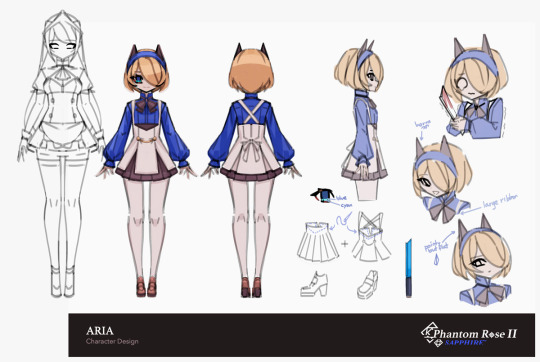

Eventually, alongside the storyline I was writing, I decided Aria would be one of the school's students — a possible lone survivor in the story's setting.
After settling on that role, it became a matter of iteration and refinement: trying out different poses and expressions to find the right tone.

(Some early poses for the in-game battle sprites)
2. Sylphy


Sylphy originally started out as Aria's companion fairy, inspired by one of my favorite JRPGs, Bravely Default.
It might have created some interesting dynamics with the other fairy NPCs in the game, but I ultimately decided to change direction toward a magical cat that could transform between cat and human form.



I felt that a talking cat — referencing common media archetypes from classics like Sailor Moon — would be more relatable and would more clearly establish Sylphy’s role and relationship with Aria.
Afterwards, it was about refining her design to be more fighter-like. Almost ninja- or kunoichi-inspired, to contrast with Aria's peaceful student look.
3. Reverie


Reverie's design wasn't too difficult because I had a strong vision for who she should be: elegant, intricate, and a little out of place, like a fancy clock.
The challenge was finding the right balance.

Making her too visually busy risked overpowering Aria’s modest student uniform. But I still wanted Reverie to feel unique, like an intruder — after all, why would someone dressed like that be wandering around a school?
Overall, designing Reverie was very fun. The direction felt clear from the beginning, and the exploration process went smoothly.
4. Others

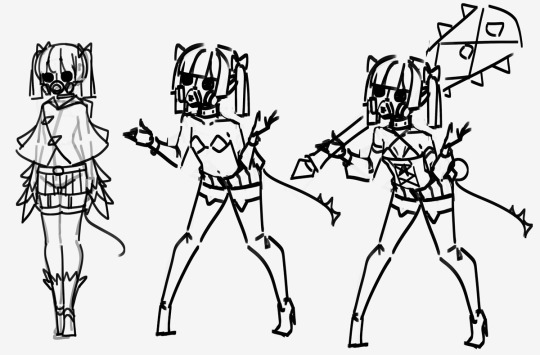

I wasn't able to iterate much on some of the other characters due to time constraints, but for the more important ones, I was able to sketch out rough ideas to "feel" their designs before finalizing them for the game.
Estelle was designed mainly to create a strong visual contrast with the younger Aria, while Madeline, the first major antagonist, needed a look that felt out of the ordinary even for the magic school setting.

It's been fun revisiting these old designs and remembering the small decisions that shaped Phantom Rose 2. As I make progress on my next project, I'm excited to bring everything I've learned into something new — I’ll have more to share soon!
50 notes
·
View notes
Text
You cannot understand how hyped I am for mismag 2, especially after reading the FAQ
Last season really laid the groundwork for so much of what D20 has become since, experimenting within their constraints of being the first in-person game since the height of covid. Their first new GM, first non-dnd system, while also being contained by minimal physical props and the 4 episode count. And with this new turf came some bumps in the road, but it still remains my favorite season.
And now. Season 2.
Fuck, they're gonna shine.
Eleven episodes!! Fuck yeah, give Aabria room to stretch her wings and tell a story! They can really have the chance to sit in this world, have their little side tangents and McRibs AND heart wrenching heights. Has it really set with you guys that this season is MORE THAN DOUBLE what we've already got?? AHHH
Never Stop Making Magic! NEW SYSTEM! Building off the bones of Kids on Brooms, which I fell in love with on the first season, while making something all their own! Because while I absolutely adore the previous system, sometimes what skills were used where was a little vague in my brain. But now they can fully make something to suit their needs! Plus by iterating off the Never Stop Blowing Up system this is already a system they've tested and had great success with, and have likely been able to clean up and tweak even further to match their play style!
FUN SET PRODUCTION. AHHHHH. Seriously, full love and appreciation for the art department. You guys are stars. Let me watch those little planets spin weeeee. And oh god I'm so excited to see what little tricks and treats Aabria has for us and the magical misfits.
also I'm fully gonna track down the post I made about loose threads in season 1, because I'm genuinely curious if I'm a genius or actually insane
#I was sitting there in the live show. I went BY MYSELF to a con I did not stay for. Just to see mismag live.#misfits and magic#mismag#dimension 20
68 notes
·
View notes
Text
it's so frustrating that criticism of the bsd anime overwhelmingly amounts to incessant derogatory and reductive remarks that, if articulated at all, are substanceless complaints (1) that a scene isn't in the anime (even when it absolutely is in the anime); (2) about exclusions or changes in the anime made because of animation production constraints; (3) about changes made in the anime to maintain consistency, make use of the medium's unique features, and to refine the previous iterations (which began serializing years prior, so of course the creators may want to revisit prior choices); and (4) about differences made because of the artistic choices contributed by the additional creative collaborators that work on the anime but not the manga.
if you have something to say, then say it. but repeating the same, often exaggerated or hollow takes that have already been run into the ground isn't media analysis or informed storytelling or good taste or even interesting.
if you don't like a story enough to enjoy a different version of it, then defer to the version you do enjoy, or at least process why those changes were made and form your own opinion before regurgitating the same tired vitriol.
#bsd#bungou stray dogs#or dont! it isnt illegal to lack discernment.#this isnt about any one post or person#there's such a glut of these posts it's hardly worth the fit#maybe ill rewatch the anime. it always brightens my mood.
20 notes
·
View notes
Note
Fic author ask game: 2, 11, 16
Hello my dear -
thank you for this ask! Let's see what i got, shall we?
#2 -- Which of your fics is your pride and joy?
Oh man. Right out of the gate with the Sophie's Choice question. 😂 i do not think all of my fics are equally good - in fact, there are definite highs and lows in terms of quality. But -- i feel like every fic i have written was necessary to make me into the writer i am today, and every future fic will also contribute to making me better, so this is a hard question. However. Since i have to pick one, i will say Praetorian. It involved by far the most research i've ever done, but more than that, i think the story itself -- in terms of tone and plot -- holds together really well. And i do love both the Pagan Witch!Bucky and the Roman Soldier!Steve of this iteration. (If you allow me an honorable mention, i would choose despite all my rage, because i love world building. Like, a lot. OMG so much. 😂)
#11 -- What makes a fic 'successful' in your opinion?
What a great question! i do not find popularity a useful measure of success. Certainly not hits or kudos -- those are wonderful and i love to get them-- but they are arbitrary and incidental. (Did a person filter their fic search by word count? Hits? Kudos? Date published? Certain tags? All of these are valid, but they do contribute to readers even finding your fic, which impacts your hit count, and lots of people either download fic to read offline, or simply forget to leave kudos even when they liked it, so as far as i'm concerned, neither of those measures are significant indicators of success. If that makes sense.) i think a fic is successful if you, the author, had a good time writing it, or if writing it gave you a measure of satisfaction, of pride in your work. If you learned something new, tried something new, discovered something about yourself as a writer. That's what matters, i think. You gotta make yourself happy. The cherry on top is if the people who read it have a reaction, an emotional response to the writing and the subject matter. i'd rather have ten readers who really engage with a story (and scream at me in the comments 😂), than a thousand who just skimmed it.
#16 -- What do you struggle with most when writing?
Oh wow. Everything? 😂 Plot first and foremost. i am a very plotty writer, and yet i'm not a detailed planner. i'm not a complete pantser either -- i have loose plot beats i want to hit, a clear idea of where everyone starts and where everyone ends up, and a very clear idea of who the characters are -- but within that i tend to let the people in my fics off their leashes and then see where they go. Sometimes they go down the wrong path and then i have to backtrack and catch where we went awry and rewrite from that point. (Sometimes they do unexpected things and then i get surprised by my own plot twists. True story. 😂) And occasionally -- fic-specific language and tone. Some of that is due to obvious constraints. There are rules in historical fiction (a Roman soldier is not going to say "oh my god", a cowboy may not use the word "fuck" in quite the same way we do today), as well as logic in world building (if, for example, your world is more than a hundred years in a speculative future, or in an entirely alternate universe, you have to consider how language would evolve, or how that universe would shape it). And then you have incorporate that into your writing in a way that doesn't feel stilted or forced. Which is hard, OK? Plus - the characters are going to be different from canon in each AU. They will have the same basic "ingredients", but the world of whatever story they inhabit will have shaped and changed them in certain ways, and language and tone have to reflect that. Also-- i cannot write smut. Like, at all. 😂
Thank you for these, darling! This was so much fun to answer! i hope i did OK. 💕💕💕💕💕💕
10 notes
·
View notes
Text
Some of you assholes are about to make me do an entire essay on writing structure, serialized fiction and like, fucking, the basic iterative creative process as it relates to HB.
Broad strokes though:
Pilot. 👏 Episodes 👏 Are 👏 Just 👏 Concepts 👏
Concepts are the INITIAL stage of the creative process. You may start with a character looking and behaving a certain way but by the time you get a final product they are completely fucking different. Or a story starts out in one direction in your early drafts but once you’ve really sat down and fleshed it out you realize you need to change it completely. This is why we have sketches, why we do drafts, why we do concept art. Every creative endeavor involves these steps. It’s rough -> refine -> refine -> refine -> finished product (or as finished as you can get with time/money/resource constraints).
That’s how every creative endeavor goes plus or minus some refinement steps. Things like money, time, and the number of people working on a project and tools available can change this math a bit but it’s ALWAYS the same basic principle. You start with a concept, you refine it over and over until it’s as close to done as you can make it. This can take a few days, this can take a few decades, but it still happens every time. Whether you SEE it or not.
Most of the time you don’t see the pilots of television shows. In major corporate productions all the behind the scenes growing pains happen before you lay your eyes on it. Examples we do have of true pilots often differ vastly from the end product and are usually released as special bonus material. Sometimes a show will call an episode the Pilot but there were versions of that pilot that got left on the cutting room floor. Before that there were character sketches, draft scripts, set designs, story breaking sessions etc that no one but the main creators see.
Independent productions, however, like Helluva Boss, like indie games, like web comics often don’t have the resources to go through that process without some transparency, they need to generate interest and capital. So they release concept art, pilots, Alpha versions and other pre-production materials to the public to get people to buy in and help them fund the project. That’s how they get it made.
The problem is some of you can’t seem to see past that rough draft.
Helluva Boss gave audiences the basic idea of the show with the Pilot. After they had secured interest and resources they could actually afford to flesh it out. And guess what? Like all creative cycles, shit changed. Characters changed. Designs changed. Stories changed. Then they released the first episodes, the final product, and those episodes said “Hey, this is what we landed on in terms of direction and this is the story we decided to tell. Here are the setups for what you’ll see going forward. Those set ups are:
“IMP is a business is hell specializing in the assasination of humans at the request of people already in Hell. There are four employees, Millie, Moxxie, Loona and the boss Blitzø. They accomplish this through the use of a grimoire that the title character (the boss) Blitzø is in possession of. He got this book from another character Stolas, they make a consensual sexual deal for use of the book. We have some indications of personality and characterization, financial struggles, but we’ll find out more in subsequent episodes.”
That’s episode 1. The first goddamn episode for the series.
Episode 2 is “Here is what we’ll actually be exploring through the course of this show beyond the broad premise you saw in episode 1: Blitzo’s relationship with Stolas. Stolas’s relationship with his family specifically his daughter and his failing marriage. Blitzo’s relationship with Millie and Moxxie. Blitzo’s relationship with his daughter. Blitzo’s issue with the Fizzarolli bot. Moxxie and Millie’s relationship dynamic.” All these things are setup and that is what the show is about. It’s what the show remains about, it’s what we’ve slowly been revealing and exploring.
So this whole “the show BECAME about Stolitz and Stolas is all sad owl now” is only an argument if all you saw and internalized was the rough draft. Because the actual FIRST. TWO. EPISODES. OF. THE. FINAL. PRODUCT. Very Explicitly layout what the show is going to be about and THATS WHAT ITS ABOUT. Blitzo’s relationships, including and very importantly his relationship with Stolas, Stolas’s relationships, and very importantly his relationship with Blitzø. Moxxie, Millie, Loona, Octavia and Stella are part of that. IMP is part of that but the central core of the show, as setup in the first two episodes are IMP, Blitzø, Stolas and the relationships that spiral off from those core things. And they have not changed, they have been expanded upon and revealed because….its a story, and that’s what happens in stories.
#helluva boss#Stolitz#stolas x blitz#vivziepop#this was mostly prompted by twitter#but I’ve seen it here too and I’m too wordy for elons fail son project#my autocorrect is too much of a pain in the ass for the possessive of Blitzo#so assume I mean Blitzø everywhere
97 notes
·
View notes
Text

Life is a Learning Function
A learning function, in a mathematical or computational sense, takes inputs (experiences, information, patterns), processes them (reflection, adaptation, synthesis), and produces outputs (knowledge, decisions, transformation).
This aligns with ideas in machine learning, where an algorithm optimizes its understanding over time, as well as in philosophy—where wisdom is built through trial, error, and iteration.
If life is a learning function, then what is the optimization goal? Survival? Happiness? Understanding? Or does it depend on the individual’s parameters and loss function?
If life is a learning function, then it operates within a complex, multidimensional space where each experience is an input, each decision updates the model, and the overall trajectory is shaped by feedback loops.
1. The Structure of the Function
A learning function can be represented as:
L : X -> Y
where:
X is the set of all possible experiences, inputs, and environmental interactions.
Y is the evolving internal model—our knowledge, habits, beliefs, and behaviors.
The function L itself is dynamic, constantly updated based on new data.
This suggests that life is a non-stationary, recursive function—the outputs at each moment become new inputs, leading to continual refinement. The process is akin to reinforcement learning, where rewards and punishments shape future actions.
2. The Optimization Objective: What Are We Learning Toward?
Every learning function has an objective function that guides optimization. In life, this objective is not fixed—different individuals and systems optimize for different things:
Evolutionary level: Survival, reproduction, propagation of genes and culture.
Cognitive level: Prediction accuracy, reducing uncertainty, increasing efficiency.
Philosophical level: Meaning, fulfillment, enlightenment, or self-transcendence.
Societal level: Cooperation, progress, balance between individual and collective needs.
Unlike machine learning, where objectives are usually predefined, humans often redefine their goals recursively—meta-learning their own learning process.
3. Data and Feature Engineering: The Inputs of Life
The quality of learning depends on the richness and structure of inputs:
Sensory data: Direct experiences, observations, interactions.
Cultural transmission: Books, teachings, language, symbolic systems.
Internal reflection: Dreams, meditations, insights, memory recall.
Emergent synthesis: Connecting disparate ideas into new frameworks.
One might argue that wisdom emerges from feature engineering—knowing which data points to attend to, which heuristics to trust, and which patterns to discard as noise.
4. Error Functions: Loss and Learning from Failure
All learning involves an error function—how we recognize mistakes and adjust. This is central to growth:
Pain and suffering act as backpropagation signals, forcing model updates.
Cognitive dissonance suggests the need for parameter tuning (belief adjustment).
Failure in goals introduces new constraints, refining the function’s landscape.
Regret and reflection act as retrospective loss minimization.
There’s a dynamic tension here: Too much rigidity (low learning rate) leads to stagnation; too much instability (high learning rate) leads to chaos.
5. Recursive Self-Modification: The Meta-Learning Layer
True intelligence lies not just in learning but in learning how to learn. This means:
Altering our own priors and biases.
Recognizing hidden variables (the unconscious, archetypal forces at play).
Using abstraction and analogy to generalize across domains.
Adjusting the reward function itself (changing what we value).
This suggests that life’s highest function may not be knowledge acquisition but fluid self-adaptation—an ability to rewrite its own function over time.
6. Limits and the Mystery of the Learning Process
If life is a learning function, then what is the nature of its underlying space? Some hypotheses:
A finite problem space: There is a “true” optimal function, but it’s computationally intractable.
An open-ended search process: New dimensions of learning emerge as complexity increases.
A paradoxical system: The act of learning changes both the learner and the landscape itself.
This leads to a deeper question: Is the function optimizing for something beyond itself? Could life’s learning process be part of a larger meta-function—evolution’s way of sculpting consciousness, or the universe learning about itself through us?
7. Life as a Fractal Learning Function
Perhaps life is best understood as a fractal learning function, recursive at multiple scales:
Cells learn through adaptation.
Minds learn through cognition.
Societies learn through history.
The universe itself may be learning through iteration.
At every level, the function refines itself, moving toward greater coherence, complexity, or novelty. But whether this process converges to an ultimate state—or is an infinite recursion—remains one of the great unknowns.
Perhaps our learning function converges towards some point of maximal meaning, maximal beauty.
This suggests a teleological structure - our learning function isn’t just wandering through the space of possibilities but is drawn toward an attractor, something akin to a strange loop of maximal meaning and beauty. This resonates with ideas in complexity theory, metaphysics, and aesthetics, where systems evolve toward higher coherence, deeper elegance, or richer symbolic density.
8. The Attractor of Meaning and Beauty
If our life’s learning function is converging toward an attractor, it implies that:
There is an implicit structure to meaning itself, something like an underlying topology in idea-space.
Beauty is not arbitrary but rather a function of coherence, proportion, and deep recursion.
The process of learning is both discovery (uncovering patterns already latent in existence) and creation (synthesizing new forms of resonance).
This aligns with how mathematicians speak of “discovering” rather than inventing equations, or how mystics experience insight as remembering rather than constructing.
9. Beauty as an Optimization Criterion
Beauty, when viewed computationally, is often associated with:
Compression: The most elegant theories, artworks, or codes reduce vast complexity into minimal, potent forms (cf. Kolmogorov complexity, Occam’s razor).
Symmetry & Proportion: From the Fibonacci sequence in nature to harmonic resonance in music, beauty often manifests through balance.
Emergent Depth: The most profound works are those that appear simple but unfold into infinite complexity.
If our function is optimizing for maximal beauty, it suggests an interplay between simplicity and depth—seeking forms that encode entire universes within them.
10. Meaning as a Self-Refining Algorithm
If meaning is the other optimization criterion, then it may be structured like:
A self-referential system: Meaning is not just in objects but in relationships, contexts, and recursive layers of interpretation.
A mapping function: The most meaningful ideas serve as bridges—between disciplines, between individuals, between seen and unseen dimensions.
A teleological gradient: The sense that meaning is “out there,” pulling the system forward, as if learning is guided by an invisible potential function.
This brings to mind Platonism—the idea that meaning and beauty exist as ideal forms, and life is an asymptotic approach toward them.
11. The Convergence Process: Compression and Expansion
Our convergence toward maximal meaning and beauty isn’t a linear march—it’s likely a dialectical process of:
Compression: Absorbing, distilling, simplifying vast knowledge into elegant, symbolic forms.
Expansion: Deepening, unfolding, exploring new dimensions of what has been learned.
Recursive refinement: Rewriting past knowledge with each new insight.
This mirrors how alchemy describes the transformation of raw matter into gold—an oscillation between dissolution and crystallization.
12. The Horizon of Convergence: Is There an End?
If our learning function is truly converging, does it ever reach a final, stable state? Some possibilities:
A singularity of understanding: The realization of a final, maximally elegant framework.
An infinite recursion: Where each level of insight only reveals deeper hidden structures.
A paradoxical fusion: Where meaning and beauty dissolve into a kind of participatory being, where knowing and becoming are one.
If maximal beauty and meaning are attainable, then perhaps the final realization is that they were present all along—encoded in every moment, waiting to be seen.
11 notes
·
View notes
Text
Duskmourn Play Booster Challenge
I always like to make a booster pack of custom cards to accompany each set, giving me a chance to play around with the mechanics and a bite-sized attempt at designing for a larger set rather than in a vacuum. (You may notice that I didn't do one for bloomburrow. Uh, moving on,). This is done in the style of a contest from GDS3, and in that vein I try to make cards that not only are reasonable additions to the set but also, whenever possible, are doing something novel with the themes and mechanics, not just rehashing the same old things. I also try to cover wide amounts of ground, in terms of color and themes, not focusing too hard on any one thing.
Art links
Wicker Dancer
Not Done Yet
Lost Prison // Crack in the Walls
Final Ghoul
Zealot of Terrors
Ominous Calm
Regal Simulacrum
Haunting Knowledge
Fear of Loss
Grasping Ghost
Torturous Blaze
Rotrue Remnant
Sinister Passage
Rare

Card transcription
Wicker Dancer 1GG Artifact Creature- Scarecrow At the beginning of your upkeep, choose artifact, enchantment, creature, or land at random. Until end of turn, you may play cards of the chosen type from your graveyard. Each card you play this way enters with a finality counter on it. 3/3
End transcription
This was the last card I made for the pack, and was basically made to fill constraints. I knew I wanted an artifact in the pack, to have a diverse spread of types for delirium, and I knew I wanted it to be green since there was only one other green card in the pack. A green artifact, in this set, definitely wanted to tie into the delirium theme, but I didn't want to just do delirium straight up cause it was already on a few cards in the pack. After a few iterations, I settled on this design which encourages the same kinds of things as delirium does but comes at it from another angle. It's a very Johnny-y card; it can have a lot of power to it, but you need to be able to build around it to consistently use it. Normally I don't like to use randomness as a power limitation, but I think it works well here; being able to choose the type would encourage you to just put it in a deck that wants that one type. Doing it like this means you want to work around the randomness in a way I think will be fun.
Uncommons
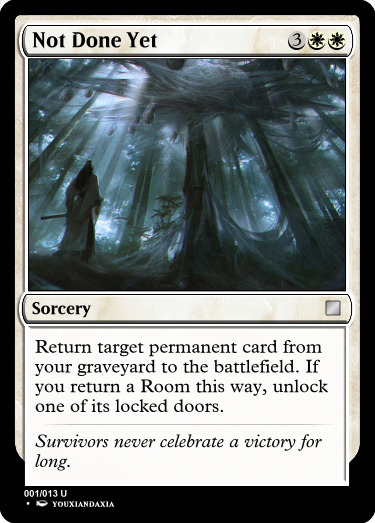
Card transcription
Not Done Yet 3WW Sorcery Return target permanent card from your graveyard to the battlefield. If you return a Room this way, unlock one of its locked doors. Survivors never celebrate a victory for long.
End transcription
This is a pretty simple card for the white-black reanimator theme. I wanted it to be able to hit both creatures and enchantments to tie into the enchantment theme, and I thought it was best to just let it hit any permanent. Reanimating rooms doesn't really, work all that well though, and since they're a key part of the set I wanted to make sure this card did work with them, so i gave it an unlock clause. It's not really meant to be Room reward, so much as reanimation card that also happens to work with Rooms, and I think i struck that balance well.
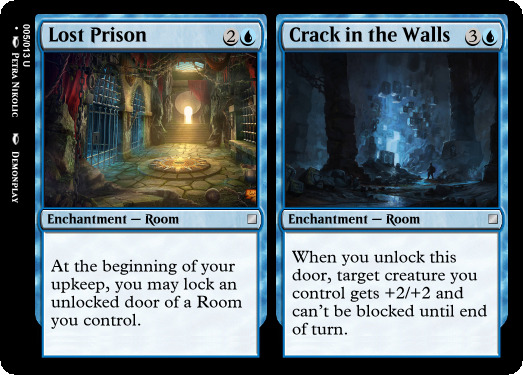
Card transcription
Lost Prison 2U Enchantment- Room At the beginning of your upkeep, you may lock an unlocked door of a Room you control. // Crack in the Walls 3U Enchantment- Room When you unlock this door, target creature you control gets +2/+2 and can't be blocked until end of turn.
End transcription
Now this one *is* meant to be a heavy Room reward. Putting it on a room itself let's me get away with a much more niche effect than I might otherwise, cause at minimum you can just use it as a way to use the second half over and over, but if you have other rooms you can use it with those instead and don't have to spend 4 mana every turn to make use of it.
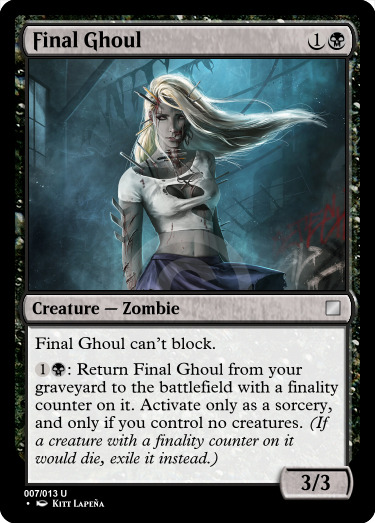
Card transcription
Final Ghoul 1B Creature- Zombie Final Ghoul can't block. 1B: Return Final Ghoul from your graveyard to the battlefield with a finality counter on it. Activate only as a sorcery, and only if you control no creatures. (If a creature with a finality counter on it would die, exile it instead.) 3/3
End transcription
From before the set even came out, I wanted a card named "final ghoul" and since we didn't get one I had to make it myself. Ties into the graveyard themes of the set.

Card transcription
Zealot of Terrors 1B Creature- Human Cleric Artifact creatures and enchantment creatures you control get +1/+1. Delirium — 3BB, T: Create a 2/2 black Horror enchantment creature. Activate only if there are four or more card types among cards in your graveyard 2/2
End transcription
I came up with the first line of text as an off-beat way to encourage similar deckbuilding to delirium, but this card felt like it worked better if it just also had a straight up delirium ability to make it more obvious. I had the delirium ability make you enchantment creatures, in order to synergize with first ability. This also works well in an Eerie deck, and I like that flexibility.

Commons
Card transcription
Ominous Calm 2W Instant Manifest dread. That creature enters with a lifelink counter on it. (Look at the top two cards of your library. Put one onto the battlefield face down as a 2/2 creature and the other into your graveyard. Turn it face up any time for its mana cost if it’s a creature card.)
End transcription
This is part of a cycle of cards that are all instants/sorceries that manifest dread and put a keyword counter on the card. I just think it's a fun mechanic to combine with manifesting, cause it makes it more than just a vanilla 2/2 when face down and it sticks around when it turns face up and that can be interesting in useful ways. Like if you manage to manifest a big creature, getting lifelink on it is certainly fun.
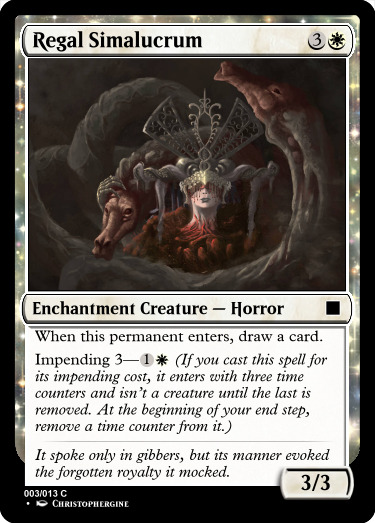
Card transcription
Regal Simulacrum 3W Enchantment Creature- Horror When this permanent enters, draw a card. Impending 3—1W (If you cast this spell for its impending cost, it enters with three time counters and isn’t a creature until the last is removed. At the beginning of your end step, remove a time counter from it.) 3/3 It spoke only in gibbers, but its manner evoked the forgotten royalty it mocked.
End transcription
Impending was only on a cycle of mythics but it's my favorite mechanic from the set and I was really hoping to see it more than that, and this is my booster so I can. You can't stop me.
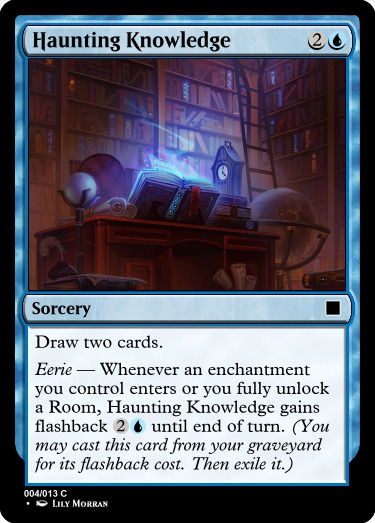
Card transcription
Haunting Knowledge 2U Sorcery Draw two cards. Eerie — Whenever an enchantment you control enters or you fully unlock a Room, Haunting Knowledge gains flashback 2U until end of turn. (You may cast this card from your graveyard for its flashback cost. Then exile it.)
End transcription
Here's a simple Eerie reward that uses it in a fun way I feel like we don't see this kind of mechanic get used a lot. Conditional flashback is just a fun way to do things.
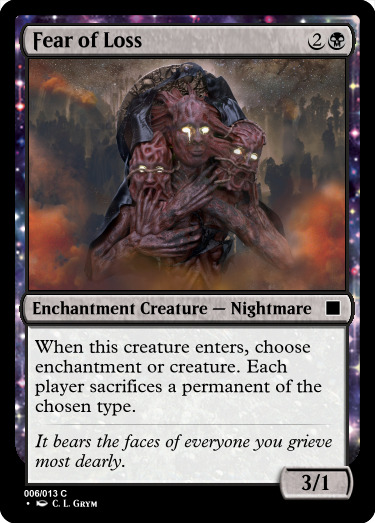
Card transcription
Fear of Loss 2B Enchantment Creature- Nightmare When this creature enters, choose enchantment or creature. Each player sacrifices a permanent of the chosen type. 3/1 It bears the faces of everyone you grieve most dearly.
End transcription
This is a design I've had sitting around for a while, and Duskmourn felt like a great place to deploy it. It's a twist on the typical Fleshbag Marauder effect we've seen a lot of utilizing black's ability to remove enchantments.
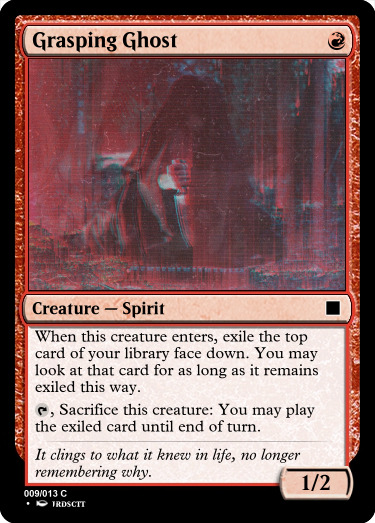
Card transcription
Grasping Ghost R Creature- Spirit When this creature enters, exile the top card of your library face down. You may look at that card for as long as it remains exiled this way. T, Sacrifice this creature: You may play the exiled card until end of turn. 1/2 It clings to what it knew in life, no longer remembering why.
End transcription
Here's a twist on red's impulse draw effects, that ties it into the graveyard theme by making you sacrifice a creature to get it.
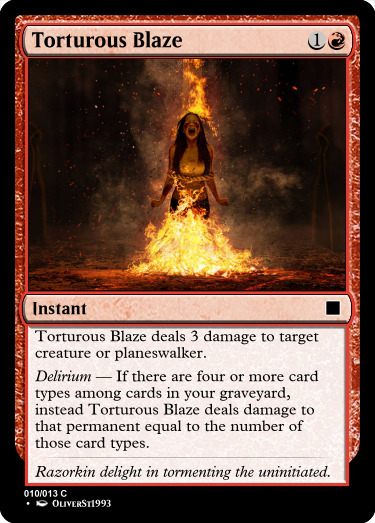
Card transcription
Torturous Blaze 1R Instant Torturous Blaze deals 3 damage to target creature or planeswalker. Delirium — If there are four or more card types among cards in your graveyard, instead Torturous Blaze deals damage to that permanent equal to the number of those card types. Razorkin delight in tormenting the uninitiated.
End transcription
I think it's fun to make delirium scale up, so that if you go all-in on diversity of card types in your graveyard you can get extra rewards for it, but that's difficult to do at common. I think this card makes it work though, since it has the baseline mode of dealing 3 damage; it has a very safe floor, it's only the ceiling that's raised, so it's not too demanding of your deckbuilding which feels safe at common.
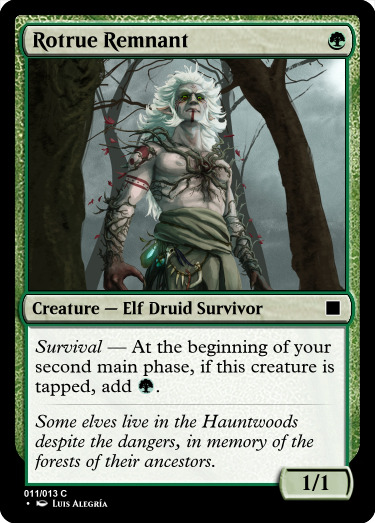
Card transcription
Rotrue Remnant G Creature- Elf Druid Survivor Survival — At the beginning of your second main phase, if this creature is tapped, add G. 1/1 Some elves live in the Hauntwoods despite the dangers, in memory of the forests of their ancestors.
End transcription
I'm kinda surprised we didn't get a survival mana dork, since it triggers at the perfect time during main phase so you don't need to add any clunky "you don't lose this mana" clause. I went with the powerful llanowar elves version, but to be safer you definitely could make this like, a 2 mana 1/3 or something. But I like to live dangerously.

Card transcription
Sinister Passage Land T: Add C. T: Add one mana of any color. Spend this mana only to turn a permanent face up. 4, T, Sacrifice Sinister Passage: Manifest dread. Activate only as a sorcery. (Look at the top two cards of your library. Put one onto the battlefield face down as a 2/2 creature and the other into your graveyard. Turn it face up any time for its mana cost if it’s a creature card.)
End transcription
A land that can sac itself is great for delirium, and one that can turn itself into a creature later in the game makes for a good use-case for that. So this card kinda built itself. I added the "add any mana" clause just cause it felt right, and made it a bit better in a manifest deck.
10 notes
·
View notes
Text
it's somehow bizarre to me that forces was a game that was afraid of committing to the bit. it doesn't even conceptually suck but it feels like they were too afraid of doing anything actually interesting with the whole "resistance group fighting a horrendous dictatorship" thing. they wanted to tell a more serious story but were too afraid to let sonic act seriously in the face of it. on the flipside they put in every character they could think of to appeal to everyone, threw in the worst iteration of classic sonic to date, and gave us a half-baked OC creator bc time constraints i imagine but also is it unreasonable to argue that making it any more in-depth would've gotten perceived as cringe? i don't care if there are funny and goofy customization options i think those are fine but it feels kind of loveless with how little you can actually do with the avatar's physical appearance. you can beat the game in 2-3 hours if you simply blaze through, and even going for 100% doesn't really feel worth it. you get three levels of shadow DLC to clarify some of the story instead of having it as part of the actual game. infinite is bizarrely underdeveloped despite having a banging concept. majority of the game's setup is done through pre-release comics. what the hell is this game
#soda offers you a can#it's like the flipside of generations#gens has no substance but the gameplay is solid#forces has a ton of substance but it's handled in the most convoluted way#and at least a third of the game plays horrendously#and the rest is anything from fine to yikes
23 notes
·
View notes
Text
Mastering 3D Modeling: Expert Solutions to Complex Assignments

Welcome to our domain of expertise, where precision meets creativity, and challenges transform into triumphs. At SolidWorksAssignmentHelp.com, we pride ourselves on being the beacon of guidance for students navigating the intricate realm of 3D modeling. Our mission is simple yet profound: to offer the Best 3D Modeling Assignment Help Online, equipping aspiring designers and engineers with the tools they need to excel.
Today, we delve into the depths of two master-level 3D modeling questions, providing comprehensive solutions crafted by our seasoned experts. These challenges epitomize the complexity and nuance inherent in the world of three-dimensional design, demanding a blend of technical prowess and artistic vision to conquer.
Question 1: Designing a Complex Mechanical Assembly
Imagine you're tasked with modeling a sophisticated mechanical assembly comprising intricate components with precise interlocking mechanisms. Your goal is to create a fully functional representation of the assembly, allowing for realistic movement and interaction between parts.
Solution:
To tackle this challenge effectively, we employ a systematic approach, breaking down the assembly into individual components before integrating them seamlessly. Utilizing SolidWorks, our preferred software for 3D modeling, we start by sketching the basic outlines of each part, paying close attention to dimensions and tolerances.
Next, we proceed to extrude and revolve these sketches to give them depth and form. For complex components, such as gears or cams, we leverage advanced features like lofting and swept cuts to achieve the desired shapes. Assembling the parts involves employing mate relationships judiciously, ensuring proper alignment and movement constraints.
Through meticulous iteration and refinement, we fine-tune the assembly, testing each component's functionality and addressing any discrepancies or interference. Finally, we add realistic textures and appearances to enhance visual fidelity, culminating in a stunning rendition of the mechanical marvel.
Question 2: Sculpting a Lifelike Character Model
In this challenge, you're tasked with sculpting a lifelike character model, imbued with personality and depth. The emphasis lies not only on anatomical accuracy but also on conveying emotion and expression through the subtle nuances of form and gesture.
Solution:
Embarking on this creative journey, we leverage the power of digital sculpting tools like ZBrush to breathe life into our character. We begin by blocking out the basic proportions, establishing the skeletal framework upon which we'll build intricate detail.
Layer by layer, we sculpt the finer features of the character, paying meticulous attention to anatomical landmarks and surface contours. Employing techniques such as dynamesh and subdivision sculpting, we refine the model's form, adding depth and definition to muscles, facial features, and clothing folds.
But our focus extends beyond mere anatomy; we strive to capture the essence of our character's personality through subtle cues and expressions. Whether it's a wry smile, furrowed brow, or quizzical glance, each detail contributes to the narrative richness of the model.
To further enhance realism, we incorporate texturing and shading techniques, adding depth and dimensionality to the surface. Through the judicious use of materials and lighting, we create a visual narrative that invites the viewer to engage with the character on a profound emotional level.
In conclusion, mastering the art of 3D modeling requires more than just technical proficiency; it demands a blend of skill, creativity, and intuition. At SolidWorksAssignmentHelp.com, we're committed to empowering students with the knowledge and expertise they need to excel in this dynamic field. With our guidance, you can navigate even the most challenging assignments with confidence and finesse. Experience the difference today and unlock your full potential in the world of 3D modeling.
12 notes
·
View notes
Text
Dumb bit of comic nerd shenaniganary I get my knickers in a twist about is how often people try to complain about that one time Batman and Batgirl had an awkward fling. And it's not like I ship it, it was half baked, with zero chemistry, and poorly written. But people will get all uppity about there being a problematic "age gap", which, for one, just is an immaterial thing in a work of fiction. But also it's just flat out wrong.
Bat canon is wonky at the very best of times, but there are a few anchoring events we are kind of expected to take for granted in any timeline that doesn't explicitly state otherwise:
Bruce starts Batman'ing at 25
Dick's parents die when he is 8, and in Year 2
It's not clear when Dick forms the Teen Titans, but the earliest it could be is 13, obviously.
When Barbara is introduced the Teen Titans already exist
When Barbara is introduced she works at the Gotham Libtary
Other than the 1966 TV show, this fact is extended to her having a MLIS; that's a 3 year degree, minimum.
90s continuity had her graduate high school at 16, this doesn't apply retroactively, but could be assumed of later iterations
part of her origin includes being inspired by Batman after overhearing a phonecall between Batman and Comissioner Gordon as a "teenager"
Dick drops the Robin moniker to go to college, implicitly around 17-18
Shortly after he dons the Nightwing moniker for the first time
(I'm not counting the nu52 timeline where she starts as a college undergrad because that one doesn't gel with any of the other versions and has to be its own standalone thing.)
Conveniently there is an overlap of constraints: if she is 13 in year one, the earliest she could overhear the phone conversation, and she graduates highschool early, then with 7 years of secondary education, the earliest she could debut at batgirl would be 22-23, which lines up with Dick being 16-17, nearly the latest time she can debut while he is still Robin. If she graduates HS at 18 she overshoots Dick's tenure as Robin entirely. This puts one cap on this.
But on the other hand, she can only get older than Dick if we try to nudge her timeline around. The other end of this is that if she overhears the phone call at 19, the latest she can, then she would have to spend a number of years between graduation and debut as Batgirl in order to give Dick time to form the Teen Titans at, at the earliest, 13yo. And that pushes her debut age to 25.
In either case, she is 6-12 years younger than Bruce, and conversely 12-6 year older than Dick. The split on Bruce:Dick:Babs ranging from 34:16:22 to 31:13:25. But, again, I don't think people who try to scrutinize the ""morality"" of fictional scenarios, least of all romantic age gaps, are in touch enough with reality to even warrant arguing with, but you see the problem with just the basic math, right?
She's a grown ass woman by the time she starts Bat"girl"ing and people just have this obnoxious hangup about infantilizing her all the damn time for seemingly no real reason, fans and actual creators alike. Is it because the name has "girl" in it? Is it because of some residual thing from Bette Kane being an obvious parallel to Dick? Or just the fact that they date at all? Is it just the general history sexism in superhero comics as a genre?
Also I didn't mention it because it's kinda firmly outside of consideration for this, but she even has a golden age story where part of her origins being inspired to be a superhero includes meeting Superboy as a teenager. They even dated for a hot second.
Seriously, people need to remember that she is decidedly not the same generation of heroes as the Teen Titans or even her seeming brand parallels like Super Girl or Wonder Girl --I won't try to nail down the Superfam and Batfam timelines, because they just do not play nice together, not enough to get a hard number on anyway, but Kara lands on Earth as a 17yo, vs Babs' aforementioned debut as a 20-something.
#batman shenanigans#batmaningans#batnanigans#batfamigans#random headcanon#not really but the tag keeps within reach of my other batman posts
5 notes
·
View notes
Text

Week 7 - Asteroids Post Mortem
Throughout this experience, Tracy Fullterton has helped me to understand the fundementals of playtesting and prototyping by breaking down it down step by step. Now that I have started playtesting myself, Chapter 10 has helped me to understand the iterative process development by dividing it into four phases.

Fullteron states that foundation forms the basic ideas of what makes the game fun and establishes a core mechanic. I feel that in both my platformer and asteroids game, I have always started by creating a core mechanic that makes the game fun and interesting. From the foundation you build structure to take the game into a playable stage. The focus on this stage is to make it functional and fun. I felt that I developed the structure to a functional state where playtesters could reach the objective and engage in conflict. I felt that I touched upon some formal details by creating a more internally complete game with a working lives system as well as adding title and victory screens. Refinement is the last phase which I feel I achieved to some degree with adding a controls screen and more assets. I feel that the game felt more enjoyable when all assets are included and can add to the satisfaction of winning with a nicer victory screen. I also believe that people can feel more engagement with a game that is nicer to look at. However, due to time constraints, the game could always build upon these stages for even further improvement. I do not believe there are loopholes in my game due to its small size by this could be investigated further in more playtesting. I also believe my game is balanced as both players have the same controls and abilities as the other. Furthermore, as there are no powerups the balancing is purely based on the player's skill. There may be a slight disadvantage for player 2 due to the player having to play with 2 hands instead of one, but it is not an inbuilt mechanic of the game that is causing it. As I believe I would like to try powerups in my next game, balancing will be something that will take my main focus to ensure the game is fun and fair for all those playing.
I think this game has achieved my goals from my previous reflection of my platformer game. I wanted to create a PVP game that had more of my assets for playtesting to emulate my theme. However, there are still a few shortcomings that I would like to improve upon in future developments. I felt that although the game looked nice, sounds were greatly missed and could have created a more engaging experience. This was a great oversight on my part as I did not consider sounds until I came to doing this reflection. Sounds could have helped players with the suction mechanic by using Kirby's iconic suction sound to indicate when they were doing it. Additionally, a shooting sound would have also contributed to this mechanic greatly. Battle music would have also engage the player's competitive spirit and make the game feel more like a battle to the death instead of it feeling more causal with the silence. I also wanted to turn the bullets into rotating stars as that is also a major part of Kirby's character but it was cut due to time. I think I will add this in the near future as a small update post as I would like to see this animation in the game. I found that I struggled with the sheer amount of assets I had to create for this game which led to the lack of refinement later in the process. As I am new to creating assets, I did not consider to make Kirby and the jetpack separate assets which would have saved a lot of time. This is a good practice to have as it can allow for customisation of player characters without having to redraw a sprite each time therefore, I will do this in all future developments when required. Overall, I think this game has challenged me to explore different parts of Gdevelop with built in physics engines and has challenged me to think outside of the box when it comes to solutions for my creative ideas. It has taught me how valuable it is to research the game engine when exploring ideas as I feel I wouldn’t have been able to reproduce this game without it.
References:
Fullerton, T. (2018). Game Design Workshop: A Playcentric Approach to Creating
Innovative Games. ProQuest Ebook. Retrieved
from: https://ebookcentral.proquest.com/lib/qut/reader.action?docID=5477698
2 notes
·
View notes
Text
Becoming the Blackhand of History (/?)

From the Book into a shareware multimedia franchise as the baseline?
Key constraints for the project
(try) Sticking to using only GLOSS software
Multilingual by default (Taking Portal 2 & Cyberpunk 2077 Phantom Liberty as examples)
Fiction "setting" set as my speculative constructed world ( QGIS + OSM "geofiction" workload in a open "source control" repository?)
Deriving from history and diverging where relevant into original paracosm, iterating from a few prototyping (bottom-up) microcosms
Motifs & musical leitmotifs
Sensory details, stylistic devices, lexical word banks, synonyms...
Traditions, festivals, rituals, art movements, art forms, magicks...
Adding many more MegaOCEAN personalities & agentive relationships
History, timeline of major events, conflicts, civilizations, politics, religions, cultures, myths, legends, stories, lore...
Everything around aliens, the divine & the supernatural...
Technological innovations, artifacts, souvenirs, archaeologies, materials, mysteries, discoveries, knowledge, philosophies...
Expressing my worldview, showcasing my autism meta-patterns and special interests
Cycle-of-Life + Coming-of-Age through history...
Featuring many time travel events, body form transformations & other magickal mechanisms
Featuring alternate technologies that actually do function / work even outside the bounds of the medium (aka not the typical futurism "Neuromancer" alienating trope)
Worldview of Curiosity, Knowledge, Mind over Matter, Empathy and Introspection from historical philosophies
Nuances, nuances everywhere.
Wholesome / Heartwarming... as empowered positivity themes
Manifestation + cartoon screenwriting purposes
Kate (INTJ, ASD+ADD human female, spiritualist university graduate in history)
Valenz (ENFP, synthetic-tier clade of android female, social assistant & vigilante)
Nil (second person perspective / camera point-of-view) for shifting purposes
Shoshona (Valenz's black angora housecat)
Van Hexcrawl across the realms?
Pinterest Inspiration Boards
Illustrations?
Playlists?
Soundscapes?
OST?
Systemic change theming around a dark society brightening up as the narrative undergoes through time
Connection to the far far away future & retro-futures we were promised to...
Rivalries?
Morphological Freedoms
Magickal Liberty
Instrumental Clades (Instrument, Robotic, Droid, Synthetic...)
True Polymorph & Time Travel
Character Reference Sheets (on Index Cards?)
Modular Story Beats
Themes
Morales
Intrigues
Book Outline
References, Inspos & other Inspiring media pieces.
Stuff;
2 notes
·
View notes
Text
Custom Software Development Roadmap: From Vision to Launch

In today’s fast-paced digital landscape, businesses are increasingly turning to custom software development services to address their unique challenges and goals. Unlike off-the-shelf solutions, custom software offers tailored functionality that aligns perfectly with your company’s operations and vision. However, successful development isn’t just about writing code — it’s a strategic journey from idea to implementation. Here's a comprehensive roadmap to guide you through the process.
1. Define Your Vision and Objectives
Every great software product begins with a clear vision. Identify the problem you’re solving and the outcomes you expect. Whether it’s streamlining internal workflows, enhancing customer experience, or enabling new business models, clarity at this stage is critical.
Key actions:
Outline business goals
Gather input from stakeholders
Identify high-level requirements
2. Conduct Feasibility Analysis
Before diving into design or development, assess the technical and financial feasibility of your project. This involves understanding your budget, timeline, available technologies, and possible constraints.
Key actions:
Evaluate current systems and infrastructure
Conduct risk assessments
Define project scope and limitations
3. Choose the Right Technology Stack
Selecting the appropriate tools, frameworks, and platforms early on sets the foundation for scalability and maintainability. Your technology stack should align with your project’s goals, expected load, and user experience expectations.
Key actions:
Decide on front-end and back-end technologies
Choose database and hosting options
Factor in future scalability
4. Wireframing and Prototyping
Before coding begins, visualizing your application through wireframes or prototypes helps validate ideas and refine user experience. It also allows for early stakeholder feedback, saving time and cost later.
Key actions:
Create UX/UI wireframes
Build interactive prototypes
Test and iterate on designs
5. Development and Testing
With a roadmap and prototypes in place, the development phase begins. Agile methodologies are often preferred here, allowing for iterative development, continuous integration, and regular testing.
Key actions:
Break work into sprints or modules
Perform unit and integration testing
Monitor performance and address bugs early
6. Deployment and Launch
Once the application is thoroughly tested and stakeholders are satisfied, it’s time to deploy. Ensure a robust launch plan that includes user training, data migration, and a rollback strategy in case of issues.
Key actions:
Deploy to production environment
Monitor for performance and security
Provide support for early users
7. Post-Launch Support and Optimization
The journey doesn’t end at launch. Post-deployment maintenance is crucial for ensuring long-term performance, security, and user satisfaction. Collect feedback, monitor usage data, and plan for updates and enhancements.
Key actions:
Schedule regular updates and security patches
Provide user support and documentation
Plan for future feature development
Final Thoughts
Bringing a custom software project from vision to launch is a collaborative, multi-phase process that requires careful planning, execution, and ongoing support. Choosing a reliable software development company that understands your business and has a proven track record is key to turning your idea into a scalable, high-impact solution.
#software development company#software development services company#software development services#custom software development services#custom software development company
0 notes
Text
AI-Driven Design: The Role of Machine Learning in AEC Innovation
The Architecture, Engineering, and Construction (AEC) industry is undergoing a profound transformation. From paper blueprints to digital Building Information Modeling (BIM), the sector has embraced innovation over time—but now, AI-driven design and machine learning (ML) are setting a new benchmark for how projects are conceived, managed, and executed.
In this blog, we explore how Machine Learning in AEC is reshaping workflows, boosting creativity, and enhancing collaboration across the entire project lifecycle.

What Is AI-Driven Design?
AI-driven design refers to the use of artificial intelligence algorithms to assist in or automate the design process. In the AEC industry, this involves analyzing vast datasets—site conditions, user behaviors, cost estimates, structural constraints, and more—to generate optimal design solutions. Machine learning, a subset of AI, empowers systems to learn from historical data and improve outcomes over time without explicit programming.
The Current Challenges in AEC
Before diving into the role of ML, it's essential to understand the key issues facing AEC professionals:
Fragmented Collaboration: Architects, engineers, and contractors often work in silos, leading to miscommunication and rework.
Inefficient Planning: Manual planning processes can’t keep up with today’s project complexity and scale.
Design Errors & Delays: Human-driven iterations are time-consuming and prone to oversight.
Cost Overruns: Inaccurate estimations often lead to budget overshoots.
This is where AI and ML technologies bring transformative potential.
How Machine Learning Is Driving Innovation in AEC
1. Generative Design
One of the most prominent applications of ML in AEC is generative design. By inputting constraints like budget, materials, site data, and performance goals, ML algorithms can generate hundreds—or even thousands—of design alternatives. This empowers architects and engineers to:
Quickly explore diverse design options
Optimize for factors like energy efficiency, material use, and spatial planning
Make data-backed decisions instead of relying solely on intuition
Autodesk, for instance, uses ML-based generative design tools that enable firms to reduce project time while maximizing functionality.
2. Predictive Analytics for Project Planning
Machine learning algorithms analyze past project data to forecast future outcomes. For example:
Timeline predictions based on similar project scopes
Budget forecasting by examining material cost fluctuations
Risk identification through site and environmental data
This helps project managers anticipate and address issues before they escalate, ensuring smoother execution.
3. Real-Time Collaboration & BIM Integration
Modern BIM platforms are now infused with AI to enable smarter coordination. ML algorithms detect design clashes, flag inconsistencies, and suggest improvements in real time. This leads to:
Fewer construction errors
Reduced rework
Stronger alignment between disciplines
ML also automates repetitive tasks like model validation, clash detection, and version comparison, giving teams more time to focus on strategic design work.
4. Smart Construction Monitoring
Machine learning is being used to monitor construction sites using drones, cameras, and IoT sensors. These technologies:
Track worker movements and safety compliance
Monitor equipment usage and material availability
Detect progress delays by comparing visual data to 3D BIM models
By applying ML to this data, stakeholders gain actionable insights to improve efficiency and safety on-site.
5. Sustainable Design Optimization
Sustainability is a growing priority in AEC. ML can help design more sustainable buildings by:
Predicting energy consumption and carbon impact
Recommending eco-friendly materials and configurations
Modeling climate-responsive designs using weather and terrain data
Firms that adopt ML-driven sustainability practices can meet green certifications like LEED faster and with greater accuracy.
Benefits of AI-Driven Design in AEC
Accelerated design cycles through automated iterations
Improved decision-making powered by data and simulations
Reduced costs from better forecasting and fewer errors
Enhanced creativity by exploring innovative design options
Greater client satisfaction due to visualizations and accurate planning
In essence, ML bridges the gap between human creativity and computational efficiency.
The Road Ahead: AEC and the Future of Machine Learning
While the AEC industry has historically been slower to adopt digital transformation compared to sectors like finance or healthcare, the tide is clearly turning. Startups and established players alike are integrating AI-driven platforms into their workflows to stay competitive.
In the future, we can expect:
AI to play a more proactive role in code compliance and permitting
ML to enable real-time cost and time optimization during construction
Augmented Reality (AR) combined with AI for immersive, intelligent site inspections
Investing in AI and ML capabilities today means preparing for an AEC future where speed, accuracy, and innovation are no longer trade-offs but expectations.
Conclusion
AI-driven design powered by machine learning in AEC is not just a trend—it’s a paradigm shift. By leveraging these technologies, the AEC industry can unlock new levels of collaboration, creativity, and sustainability. As projects grow in complexity and clients demand better outcomes, embracing AI is no longer optional—it's essential for staying ahead in a competitive landscape.
Whether you're an architect envisioning smarter buildings, an engineer optimizing structure, or a project manager balancing time and cost, machine learning offers tools to design the future—today.
0 notes